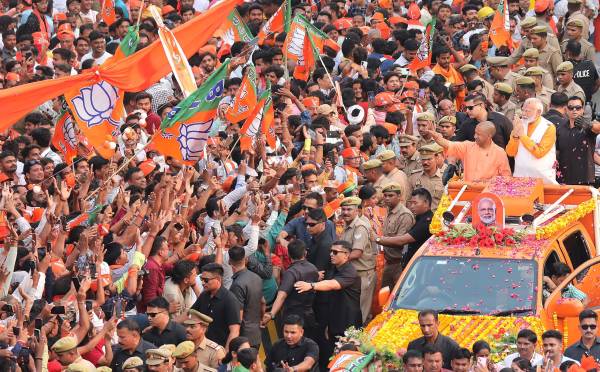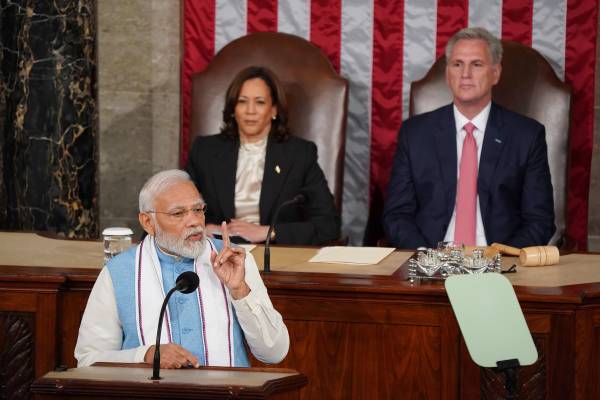印度已经开始了全世界规模最大的选举。印度总理莫迪和他的印度人民党 (BJP) 似乎已做好了胜利的准备。莫迪在印度能够长期维持如此高的支持率,背后有多种原因,例如印人党的宣传机器将莫迪不断神话,印度经济上的突出表现,以及莫迪不断以印度教民族主义旗帜来吸引普通民众等等。

当地时间2024年5月13日,印度北方邦瓦拉纳西,印度开启大选第四阶段投票,印度总理莫迪参加竞选活动。图自IC photo
外交同样为莫迪政府增分不少,除了美欧日澳领导人频繁访问印度之外,莫迪还多次受邀参加G20峰会。2023年在新德里成功地举办的G20峰会,使印度及其政治领导人在国际舞台的“能见度”得到大大提升。
显然,这多少要归功于莫迪政府的外交操盘手——外长苏杰生。他对莫迪的战略远见大加赞赏,也不吝表扬印度的外交政策,即使印度在战略上站队美国。这样的战略选择可以使得印度外交活动的空间更大,对中国、俄国和美国的战略杠杆更多,进而使得印度能够在各方竞争博弈的夹缝中不断获利。

当地时间2023年9月8日,印度G20峰会召开前夕,美国总统拜登与印度总理莫迪在新德里举行会晤。图自IC photo
新德里的外交策略无疑看上去是非常聪明且成功的。但是,从更高的战略层面上,新德里的外交能否算是成功的呢?显然,答案未必是那么清晰的。至少,新德里不仅失去了同中国和俄罗斯的传统友谊和善意,另一方面却并没有收获来自美国及其庞大盟友阵营的战略信任,成为了一个孤独的崛起大国。
在莫迪第一任期内,中印尽管爆发了边境上的洞朗对峙,但是很快两国最高领导人就在武汉进行了非正式会晤,实现了两国关系的翻篇重启。然而,在莫迪第二任期初期,中印边境上爆发加勒万冲突后,两国并没有实现关系的转圜。
加勒万冲突的爆发,很明显是印度方面的错误导致的。莫迪在事件发生后很快就承认,“(中国)没有入侵入我们的边境,我们的哨所也没有被占领”。中方的反应很克制,直到10个月之后才公布中方军官和士兵的伤亡情况。
但中国的善意却没有换来印度的同等的克制和回报。3月,有报道称印度计划向边境增派军队,这违反了2020年9月中印两国防长会晤所达成的共识。新德里以边境边界问题作为杠杆,将中印关系维持在可控制的紧张状态上,以此作为拉近同美国阵营的敲门砖。
在2022年9月上合组织撒马尔罕峰会、2022年11月巴厘岛G20峰会,以及2023年8月南非金砖峰会上,莫迪都有机会与习近平举行正式会晤并修复两国关系。但是,新德里却选择了另一条道路,这给中国释放的信号是——新德里已经在中美竞争的战略博弈中下注了美国。
印度与俄罗斯的传统友谊同样受到了俄乌冲突的考验。俄乌冲突爆发后,虽然印度没有加入谴责俄罗斯的行列,但莫迪却中止了同普京的年度会晤。购买俄罗斯石油时,印度在议价上更是“落井下石”,极力压低价格。
印度国防参谋长 阿尼尔·乔汉甚至公开评价道“俄罗斯的地缘政治影响力在未来会下降,尽管它是一个核大国”这多少反映出印度对现状的评估,也让俄罗斯意识到,印度事实上押注俄罗斯会在俄乌冲突中“战败”。
与2014年印度对克里米亚问题的官方回应相比,印度此次的做法显然让俄国人感到失望。在俄罗斯看来,两国传统友谊和信任因此受到了严重损害。
如此看来,中俄领导人都宣布不参加新德里的G20峰会,也是顺理成章的了。
与此同时,莫迪频繁受邀出现在了美西方主导的多边舞台上,印度成为了美国重要的军事伙伴。但印度和美西方国家并不是铁板一块,加拿大指控印情报部门在加刺杀了一名锡克教人士。印度对此指控做出了强势回应,这遭到了美国和英国等国的批评。美国声称自己也挫败了一场涉嫌在纽约暗杀锡克教男子的阴谋,同时英国和澳大利亚也对此感到紧张。拜登政府尽管“高高举起,轻轻放下”,但是在盎格鲁撒克逊国家看来,莫迪领导下的印度,本质上也是一个“异类”国家。

当地时间2023年6月22日,印度总理莫迪受邀在美国国会发表演讲。图自IC photo
印度与日本的关系,在安倍晋三执政时期,确实发生了重要提升。但随着安倍晋三下台,日本领导人已经没有发展同印度关系的兴趣和热情了。由日本承建的,从印度孟买到艾哈迈巴德的高铁项目于2017年动工,但目前工程进度面临全面延期,预计于2026年才能投入运营。而日本与印度为了对抗中国的“一带一路”倡议而共同提出的“亚非增长走廊”倡议,迄今没有任何实际进展。
日本极力拉印度加入RCEP以扩展自身经济联盟并平衡中国的经济影响力,但是印度却最终退出了RCEP。而印度对日本企业在印投资激增的幻想也一再落空。 苏杰生在三月于东京举行的瑞辛纳圆桌会议上表示,“有很多欧美的商务代表团考察印度,但没有看到那么多来自日本的代表团。”
莫迪政府显然没有注意到美西方对印度崛起的整体性的战略焦虑,仍在不断宣扬印度的经济崛起的成就。印度幼稚的想法基于这样一种假设——美国及其盟友要遏制中国经济发展,就会致力于帮助印度崛起。但如果说是美国提供的国际环境促成了中国崛起,那么美国有什么理由会再次犯下同样的“错误”呢?
总而言之,过去五年的莫迪外交,以表面上的风光换来了印度在国家战略上的根本性伤害。中国有句古话,聪明反被聪明误。莫迪的外交政策,显示出印度的精明,但是却可能埋下这个国家战略悲剧的祸根。
(本文英文版首发于《南华早报》,作者授权观察者网发布中文版。)
以下为文章英文版:
As India conducts the world’s biggest election, Prime Minister Narendra Modi and his Bharatiya Janata Party (BJP) appear poised for victory. Modi’s popularity has been attributed to myriad factors, including the BJP’s adept mythologisation of the leader, India’s robust economic trajectory and Modi’s appeal to Hindu nationalism.
The performance of diplomacy is another factor. A flurry of visits from leaders of the United States, European countries, Japan and Australia, coupled with Modi’s attendance of G7 summits, have elevated India’s visibility, notably as the G20 summit host last year. The Modi administration’s diplomatic performance can be largely credited to the acumen of External Affairs Minister S. Jaishankar, who has lavished praise on Modi’s strategic vision and been forthright in defending Indian policies, even while strategically aligning with the US-led bloc.
This tactical alliance has afforded India greater diplomatic agility and leverage amid the complex dynamics of its relationships with China, Russia and even the US, enabling it to capitalise on the competitive fractures among these global powers.
New Delhi’s diplomatic manoeuvres seem shrewd and efficacious but are they really? India’s camaraderie with China and Russia has been progressively strained, while the strategic trust of the US and its allies remains tenuous, with India increasingly being seen as an isolated ascending power.
After the 2017 Doklam stand-off, India and China swiftly restarted diplomatic relations at an informal summit in Wuhan. In stark contrast, relations after the 2020 Galwan Valley clash have yet to see a similar thaw.
The events leading to the Galwan Valley clash were predominantly a result of Indian missteps. As Modi said soon after the incident, China has not “intruded into our border, nor has any post been taken over by them”. China’s reaction was restrained, only revealing its casualty numbers many months later.
But China’s goodwill has not been reciprocated. In March, it was reported that India planned to move more troops to the border in contravention of the consensus reached in September 2020. India has since leveraged the border dispute to foster a controlled tension with China, using this as a door knocker to gravitate closer to the US-led alliance. There were many opportunities for Modi and Chinese President Xi Jinping to repair relations face to face,including at the September 2022 Shanghai Cooperation
The long-standing India-Russia relationship has also been tested by the Ukraine conflict. Despite India’s refusal to condemn Russia, Modi has suspended his annual summit with Russian President Vladimir Putin and adopted a stern bargaining stance when buying Russian oil.
Last October, India’s Chief of Defence Staff Anil Chauhan said: “The geopolitical importance of Russia will go down in times to come. It is in spite of being a nuclear power.” This reflects India’s risk assessment and suggests it is wagering on Russia’s defeat in Ukraine.
Compared to India’s official response to Russia’s annexation of Crimea in 2014, its approach this time has clearly disappointed Russia. In Russia’s view, the traditional friendship and trust between the two countries has been severely damaged.
Unsurprisingly, Russia’s interactions with India have largely ceased. Neither Putin nor Xi attended the G20 summit in New Delhi last year.
In the meantime, Modi has been invited to several forums dominated by the US and its allies, and has become an important defence partner of the US.
But India’s harsh response to Canada’s allegation of an assassination plot against a Sikh activist has been criticised by the US and Britain, among others. The US says it has foiled an alleged plot to assassinate a Sikh man in New York, and tensions have been felt in Britain and Australia. If nothing else, India is showing itself up as an ill fit for the Western alliance.
With Japan, relations with India saw a marked improvement during Shinzo Abe’s tenure. But with his departure, Japanese enthusiasm for deepening ties with India has waned. The Japan-backed high-speed rail project to connect Mumbai to Ahmedabad, launched in 2017, has faced delays and is now expected to be operational by 2026. The Asia-Africa Growth Corridor, a Japan-India collaboration announced in 2017 with hopes of rivalling China’s Belt and Road Initiative, has gone nowhere.
Japan had also vigorously encouraged India’s participation in the Regional Comprehensive Economic Partnership (RCEP) as a means of diversifying economic alliances and counterbalancing China’s influence – only for India to dramatically back out at the last minute.
The hoped-for surge in Japanese business investment in India has also failed to materialise. At the Raisina Roundtable in Tokyo in March, Jaishankar said the growing Indian market has attracted many business delegations from Europe and the US “but I don’t see that many from Japan”.
The Modi administration, it seems, is overlooking any strategic anxieties that Japanese – and indeed, US and European – business communities may have over India’s rise. This may stem from an assumption that the West, intent on curbing China’s rise, will support India’s progress instead. But given that China’s rise was made possible by conditions in the international environment provided by the US, what are the chances Washington would make the same “mistake” with India?
Over the past few years, Modi’s diplomatic endeavours have prioritised quick gains over longer-term strategic advantages. India must beware of becoming a victim of its own cleverness. Modi’s diplomacy shows India’s strategic cunning – but also risks the making of a strategic misfortune for the country.






